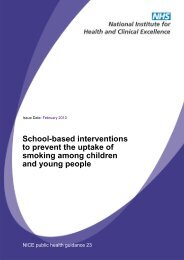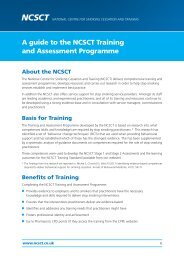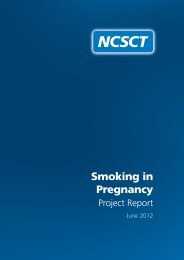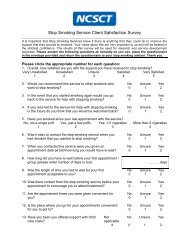Smoking and mental health - NCSCT
Smoking and mental health - NCSCT
Smoking and mental health - NCSCT
Create successful ePaper yourself
Turn your PDF publications into a flip-book with our unique Google optimized e-Paper software.
<strong>Smoking</strong> <strong>and</strong> <strong>mental</strong> <strong>health</strong><br />
between passive smoking <strong>and</strong> hyperactivity, inattention <strong>and</strong> conduct<br />
disorders. 162 Passive smoking in children has also been linked to<br />
neurocognitive testing deficits 163 <strong>and</strong> behavioural <strong>and</strong> emotional problems<br />
in general. 164<br />
7.6.3 <strong>Smoking</strong> <strong>and</strong> child <strong>and</strong> adolescent <strong>mental</strong> disorders<br />
It is well recognised that smoking is particularly common among young people<br />
with <strong>mental</strong> disorders, especially emotional <strong>and</strong> behavioural disorders. Crosssectional<br />
data indicate that, in Australia, 72% of young people with a conduct<br />
disorder had smoked within the past 30 days, as had 46% of those with<br />
depression <strong>and</strong> 38% of those with ADHD, compared with 21% of those with no<br />
<strong>mental</strong> <strong>health</strong> diagnosis. 165 In the 2004 Child <strong>and</strong> Adolescent Mental Health<br />
Survey of Great Britain, 19% of young people with an emotional disorder were<br />
classed as regular smokers, as were 15% of those with hyperkinetic disorder <strong>and</strong><br />
30% of those with conduct disorder, compared with around 6% in children<br />
without these disorders. Depression in adolescence has been associated with<br />
smoking in adulthood, whereas young people who smoke appear to be more<br />
likely to become depressed. 166 Adolescents with ADHD are more likely to smoke<br />
than their peers, to have started smoking younger 167 <strong>and</strong> to have more severe<br />
nicotine dependence. 168<br />
Theories underpinning the association with ADHD include nicotine selfmedication,<br />
whereby young people smoke to alleviate ADHD symptoms by<br />
exploiting the central nervous stimulant effects of nicotine to improve attention<br />
<strong>and</strong> cognition. 168 This theory is supported by evidence that adolescents with<br />
ADHD who are not treated with stimulant medication are more likely to<br />
smoke, 169,170 <strong>and</strong> that children with greater levels of inattention <strong>and</strong><br />
hyperactive–impulsive symptoms are more likely to be smokers. 169 Alternative<br />
hypotheses or potential confounders include the possibility that the<br />
impulsiveness, impaired inhibition <strong>and</strong> other cognitive deficits of adolescents<br />
with ADHD make it more difficult for them to resist initiating <strong>and</strong> continuing<br />
smoking, 168 or that the social disadvantages of ADHD result in greater exposure<br />
to peer smoking as a result of a higher likelihood of associating with deviant<br />
peers who are themselves more likely to smoke. 171<br />
<strong>Smoking</strong> is also more common among young people with eating disorders. The<br />
American National Longitudinal Study of Youth found that adolescent girls with<br />
a high body mass index, who reported that they were trying to lose weight, were<br />
more likely to initiate smoking than other females. 172 This association between<br />
smoking <strong>and</strong> dieting behaviours, <strong>and</strong> with disordered eating symptoms <strong>and</strong> some<br />
aspects of general weight concerns, may be more marked among females. 173<br />
Similarly, although adolescents with anorexic-restrictive eating patterns did not<br />
use smoking as a weight control strategy, body image concerns were more<br />
prevalent in girls who smoked than in those who did not. 174<br />
150 © Royal College of Physicians 2013














